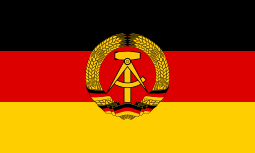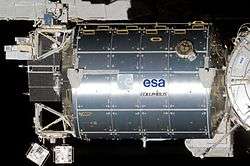European Astronaut Corps
The European Astronaut Corps is a unit of the European Space Agency (ESA) that selects, trains, and provides astronauts as crew members on U.S. and Russian space missions. As of Nov 2014, 24 ESA astronauts are now able to go board the ISS. There are currently 47 members of the Corps, 26 currently active. The European Astronaut Corps is based at the European Astronaut Centre in Cologne, Germany. They can be assigned to various projects both in Europe (at ESTEC, for instance) or elsewhere in the world, at NASA Johnson Space Center or Star City.
History
Selection of new astronauts in 2009
According to French weekly Air & Cosmos, only six astronauts (Fuglesang, Schlegel, Nespoli, Eyharts, De Winne and Kuipers) remain available for immediate flight. Vittori and Clervoy are on temporary leave or assigned to other duties. The head of human spaceflight at ESA recommended that at least four more astronauts (plus four other in reserve) should be added after the launch of Columbus in February 2008.
On April 3, 2008, ESA director general Jean-Jacques Dordain announced that recruiting for a new class of European astronauts will start in the near future.[1] The selection program for 4 new astronauts was launched on May 19, 2008 with applications due by 16 June 2008 so that final selection would be due spring 2009.[2] Almost 10 000 people registered as astronaut candidates 2008-06-18. 8413 fulfilled the initial application criteria. From these 918 were chosen to take part in the first stage of psychological testing which led to 192 candidates in 2008-09-24. After two stage psychological tests 80 candidates will continue to medical evaluation in January/February 2009. 40 or so candidates will head to a formal interviews to select the four new members to European Astronaut Corps.[2]
Future of the European Astronaut Corps
After the ISS
The funding by NASA and Russia of the International Space Station is currently planned to end in 2024. The role of European astronauts beyond this point is unclear. Some speculation suggests ESA's involvement with Nasa's Orion programme may give European astronauts a seat aboard the Orion spacecraft, although this has not been announced.
Current members
There are sixteen active members of the European Astronaut Corps.
Ten of the current members of the corps that have flown or are going to space one day. Of those, all except Jean-François Clervoy have visited the ISS. The two who have yet to fly have missions planned to the ISS aboard expeditions 46-47 and 50-51. André Kuipers is the member of the corps who has spent the most time in space, more than 203 days. The European record for total time spent in space belongs to former German astronaut Thomas Reiter with 350 days. The oldest is Hans Schlegel, born in 1951. The corps currently includes one woman, Samantha Cristoforetti. Only two other women have been members of the corps. Marianne Merchez who never flew, and Claudie Haigneré who resigned after two missions to start a political career in France.
Former members
There are thirteen former members of the ESA.[3]

 Maurizio Cheli
Maurizio Cheli
 Reinhold Ewald
Reinhold Ewald.svg.png)
 Frank De Winne
Frank De Winne
 Pedro Duque
Pedro Duque
 Umberto Guidoni
Umberto Guidoni
 Claudie Haigneré née André-Deshays
Claudie Haigneré née André-Deshays
 Jean-Pierre Haigneré
Jean-Pierre Haigneré
 Ulf Merbold
Ulf Merbold
 Marianne Merchez*
Marianne Merchez*
 Claude Nicollier
Claude Nicollier
 Wubbo Ockels
Wubbo Ockels
 Philippe Perrin
Philippe Perrin
 Thomas Reiter
Thomas Reiter
 Michel Tognini
Michel Tognini
 Gerhard Thiele
Gerhard Thiele
* No space missions
Non-ESA European astronauts/cosmonauts (excluding Russians)
Soviet Union's Interkosmos program participants
-
.svg.png)
 Aleksandr Panayotov Aleksandrov
Aleksandr Panayotov Aleksandrov -
.svg.png)
 Georgi Ivanov
Georgi Ivanov -

 Vladimír Remek
Vladimír Remek -

 Sigmund Jähn
Sigmund Jähn -

 Jean-Loup Chrétien
Jean-Loup Chrétien -

 Bertalan Farkas
Bertalan Farkas -

 Mirosław Hermaszewski
Mirosław Hermaszewski -
.svg.png)
 Dumitru Prunariu
Dumitru Prunariu
Other
-

 Klaus-Dietrich Flade
Klaus-Dietrich Flade -

 Reinhard Furrer
Reinhard Furrer -

 Ernst Messerschmid
Ernst Messerschmid -

 Ulrich Walter
Ulrich Walter -

 Patrick Baudry
Patrick Baudry -

 Jean-Jacques Favier
Jean-Jacques Favier -

 Franco Malerba
Franco Malerba -

 Dirk Frimout
Dirk Frimout -

 Franz Viehböck
Franz Viehböck -

 Ivan Bella
Ivan Bella -

 Helen Sharman
Helen Sharman
Space Shuttle missions
Astronauts from the European Astronaut Corps participated in several NASA Space Shuttle missions before the ISS era, in particular as Spacelab Payload Specialists. (This list excludes missions to Mir or the ISS)
As Payload Specialists
- Ulf Merbold - STS-9 (Spacelab), STS-42 (Spacelab)
- Reinhard Furrer - STS-61-A (Spacelab-D1 Mission)
- Wubbo Ockels - STS-61-A (Spacelab-D1 Mission)
- Hans Schlegel - STS-55 (Spacelab-D2 Mission)
- Ulrich Walter - STS-55 (Spacelab-D2 Mission)
As Mission Specialists
- Claude Nicollier - STS-46, STS-61 (Hubble), STS-75, STS-103 (Hubble)
- Libasse Diop - STS-46, STS-61 (Hubble)
- Maurizio Cheli - STS-75
- Jean-François Clervoy - STS-66, STS-103 (Hubble)
- Gerhard Thiele - STS-99
- Pedro Duque - STS-95
Missions to the Mir space stations
Astronauts from Europe have flown to Mir both on board Soyuz vehicles (as part of the Euromir programme) or on board the Space Shuttle.[4]
- Jean-Loup Chrétien - Aragatz (1988)
 France
France - Helen Sharman - Project Juno (1991)
 UK
UK - Franz Viehböck - Austromir '91 (1991)
 Austria
Austria - Klaus-Dietrich Flade - Mir '92 (1992)
 Germany
Germany - Michel Tognini - Antarès (1992)
 France
France - Jean-Pierre Haigneré - Altair (1993)
 France
France - Ulf Merbold - Euromir '94 (1994)
 Germany
Germany - Thomas Reiter - Euromir '95 (1995)
 Germany
Germany - Claudie Haigneré - Cassiopée (1996)
 France
France - Reinhold Ewald - Mir '97 (1997)
 Germany
Germany - Jean-Loup Chrétien - STS-86 (1997)
 France
France - Léopold Eyharts - Pégase (1998)
 France
France - Jean-Pierre Haigneré - Perseus (1999)
 France
France - Ivan Bella - Stefanik (1999)
 Slovakia
Slovakia
Missions to the International Space Station
European astronauts to have visited the ISS are:
| Astronaut | Agency | Mission | Launch | Return | Expedition | Launch Date | Return Date | Note |
|---|---|---|---|---|---|---|---|---|
| | ESA | STS-100 | STS-100 | Expedition 2 | 19 Apr 2001 | 1 May 2001 | Flight 6A with MPLM Raffaello | |
| | CNES | Andromède | Soyuz TM-33 | Soyuz TM-32 | Expedition 3 | 21 Oct 2001 | 31 Oct 2001 | |
| | ESA | Marco Polo | Soyuz TM-34 | Soyuz TM-33 | Expedition 4 | 25 Apr 2002 | 5 May 2002 | |
| | CNES | STS-111 | STS-111 | Expedition 4, 5 | 5 Jun 2002 | 19 Jun 2002 | ISS Assembly Flight UF-2 | |
| | ESA | Odissea | Soyuz TMA-1 | Soyuz TM-34 | Expedition 5 | 30 Oct 2002 | 10 Nov 2002 | |
| | ESA | Cervantes | Soyuz TMA-3 | Soyuz TMA-2 | Expedition 7, 8 | 18 Oct 2003 | 28 Oct 2003 | |
| | ESA | DELTA | Soyuz TMA-4 | Soyuz TMA-3 | Expedition 8, Expedition 9 | 19 Apr 2004 | 30 Apr 2004 | |
| | ESA | Eneide | Soyuz TMA-6 | Soyuz TMA-5 | Expedition 10, 11 | 15 Apr 2005 | 24 Apr 2005 | |
| | ESA | Astrolab | STS-121 | STS-116 | Expedition 13, 14 | 4 Jul 2006 | 22 Dec 2006 | ISS Assembly Flight ULF 1.1 |
| | ESA | Celsius | STS-116 | STS-116 | Expedition 14 | 10 Dec 2006 | 22 Dec 2006 | ISS Assembly Flight 12A.1 |
| | ESA | Esperia | STS-120 | STS-120 | Expedition 16 | 23 Oct 2007 | 7 Nov 2007 | ISS Assembly Flight 10A |
| | ESA | Columbus | STS-122 | STS-122 | Expedition 16 | 7 Feb 2008 | 20 Feb 2008 | ISS Assembly Flight 1E |
| | ESA | Columbus | STS-122 | STS-123 | Expedition 16 | 7 Feb 2008 | 27 Mar 2008 | ISS Assembly Flight 1E |
| | ESA | OasISS | Soyuz TMA-15 | Soyuz TMA-15 | Expedition 20, 21 | 27 May 2009 | 1 Dec 2009 | First European commander of the ISS, Expedition 21 |
| | ESA | AlISSé | STS-128 | STS-128 | Expedition 20 | 29 Aug 2009 | 12 Sep 2009 | ISS Assembly Flight 17A |
| | ESA | MagISStra | Soyuz TMA-20 | Soyuz TMA-20 | Expedition 26, 27 | 15 Dec 2010 | 24 May 2011 | |
| | ESA | DAMA | STS-134 | STS-134 | Expedition 27, 28 | 16 May 2011 | 1 Jun 2011 | |
| | ESA | PromISSe | Soyuz TMA-03M | Soyuz TMA-03M | Expedition 30, 31 | 21 Dec 2011 | 1 Jul 2012 | |
| | ESA | Volare | Soyuz TMA-09M | Soyuz TMA-09M | Expedition 36, 37 | 28 May 2013 | 11 Nov 2013 | |
| | ESA | Blue Dot | Soyuz TMA-13M | Soyuz TMA-13M | Expedition 40, 41 | 28 May 2014 | 10 Nov 2014 | |
| | ESA | Futura | Soyuz TMA-15M | Soyuz TMA-15M | Expedition 42, 43 | 23 Nov 2014 | 11 Jun 2015 | Longest uninterrupted spaceflight of a European astronaut |
| | ESA | IrISS[5] | Soyuz TMA-18M | Soyuz TMA-16M | Expedition 44 | 2 Sep 2015 | 12 Sep 2015 | |
| | ESA | Principia[6] | Soyuz TMA-19M | Soyuz TMA-19M | Expedition 46, 47 | 15 Dec 2015 | 18 June 2016 | |
| | ESA | Proxima[7] | Soyuz MS-03 | Soyuz MS-03 | Expedition 50, 51 | 17 Nov 2016 | 16 May 2017 | |
| Planned | ||||||||
| | ESA | Soyuz MS-05 | Soyuz MS-05 | Expedition 52, 53 | May 2017 | Nov 2017 | ||
| | ESA | Soyuz MS-09 | Soyuz MS-09 | Expedition 56, 57 | May 2018 | Nov 2018 | Gerst will become the second European commander of the ISS | |
See also
References
- ↑ Clark, Stephen (3 April 2008). "Europe's new cargo freighter safely docks to space station". Spaceflight Now. Retrieved 6 March 2016.
- 1 2 "Closing in on new astronauts". ESA. 24 September 2008. Retrieved 6 March 2016.
- ↑ "European astronauts in new functions". ESA. 17 September 2014. Retrieved 6 March 2016.
- ↑ "European Manned Spaceflight Patches" (PDF). ESA. 29 October 2009. Retrieved 15 December 2010.
- ↑ "The iriss name and logos". ESA. 25 November 2015. Retrieved 6 March 2016.
- ↑ "ESA mission name for astronaut Tim Peake: Principia F". ESA. 18 July 2014. Retrieved 6 March 2016.
- ↑ "Thomas Pesquet closer to space with mission name Proxima". ESA. 12 November 2015. Retrieved 6 March 2016.
- ↑ "Third spaceflight for astronaut Paolo Nespoli". ESA. 30 July 2015. Retrieved 6 March 2016.
External links
| Wikimedia Commons has media related to ESA astronauts. |



.jpg)

